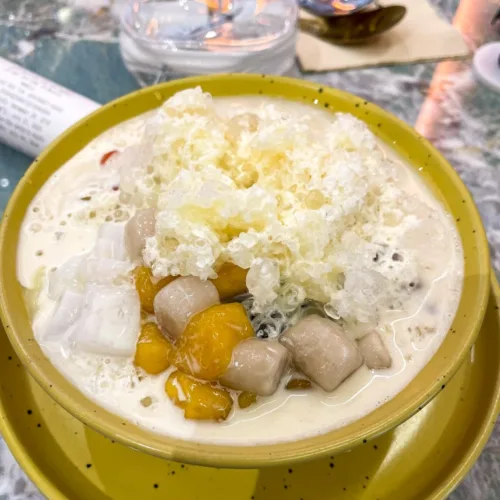Walking through the bustling streets of Binondo – the world’s oldest Chinatown established in 1594, you’d be overwhelmed by a collision of colors and flavors that reflect centuries of cultural exchange. There’d be the usual dimsum, noodles, and Chinese food. Anyhow, I was wandering around the Lucky Chinatown Mall when I got curious about a modern dessert called Uncle Fish Balls Coffee Collection. They offer a shaved ice dessert described online as featuring taro and sweet potato balls, grass jelly, goji berries, coconut jelly, snow fungus, and milk. I got excited with this because in a single bowl, it captured a confluence of culinary traditions – the sweet tong sui of Cantonese kitchens, the taro ball shaved ice of Taiwan, and the imaginative spirit of Filipino halo-halo and even binignit because it was described as having coconut milk.
Uncle Fish Balls and the Taro Ball Shaved Ice Dessert

A colorful bowl of Taiwanese-style taro and sweet potato ball dessert with grass jelly and beans
Uncle Fish Balls Coffee Collection is known for bringing Hong Kong and Taiwanese-inspired snacks to Manila, from skewered fish balls to egg waffles. Most of the customers are eating waffles. Yet among its offerings, the shaved ice dessert caught my fancy. We just ate at the Sincerity Restaurant and I was looking for something to cleanse my palate. The taro and sweet potato balls were hand-rolled from mashed root crops and tapioca starch. These are the same QQ delights beloved in Jiufen and Taipei night markets. The grass jelly provides a refreshing counterpoint with its mild herbal taste, especially when paired with sweetened milk. What truly sets this dessert apart are the traditional Chinese ingredients seldom seen in Filipino cold sweets: snow fungus and dried goji berries. Its a dessert that is at once foreign and familiar to the Filipino palate, like halo-halo reimagined with a Chinese twist.
From Tong Sui to Taiwanese Shaved Ice
To understand this dessert’s roots, one must travel back to the sweet traditions of China and Taiwan. In Cantonese cuisine, tong sui (literally “sugar water”) refers to dessert soups served warm or cold, often as a nourishing end to a meal. These concoctions, such as snow fungus soup, are lightly sweet and prized for their texture and health benefits. A Cantonese snow fungus tong sui typically simmers snow fungus with red dates, longan, barley, and rock sugar into a delicately sweet broth, finished with goji berries added at the last minute to preserve their brightness. The result is “refreshing Cantonese tong sui” meant to cool the body after a hearty meal, with snow fungus “melting in your mouth as though you’re eating clouds”. In Manila’s Chinatown, older eateries like Quik Snack have long served a traditional white fungus soup, described as a bowl of soft white fungus in golden syrup that surprisingly evokes the local sago’t gulaman drink. The Chinese sweet soup tradition had quietly lived in family kitchens and a few restaurants, nurturing generations with its promise of both dessert and tonic.
Meanwhile, in Taiwan, a very different but complementary dessert culture was thriving – one built on shaved ice and creative toppings. The use of shaved ice in Chinese communities isn’t new (variations exist all over Southeast Asia), but Taiwan took it to new heights. A prime example is the famous Jiufen taro ball dessert (九份芋圓), which originated in the hillside town of Jiufen and features plump taro and sweet potato balls served either hot in syrup or chilled over crushed ice. Taiwanese shaved ice desserts often combine the chewy taro balls with a medley of ingredients like sweetened beans, syrups, and jellies. They’re incredibly popular for their mix of textures and temperatures, and have spread across Asia through dessert chains. The dessert at Uncle Fish Balls clearly draws inspiration from these Taiwanese creations – the chewy taro and sweet potato balls and the grass jelly are textbook Taiwanese, as is the inclusion of brown sugar syrup or sweet milk as a finishing touch (a nod to popular brown sugar boba and shaved ice trends).
By combining tong sui elements (like snow fungus and goji, common in Chinese 糖水 desserts) with Taiwanese shaved ice staples (taro balls, grass jelly), the dessert bridges two worlds of Asian sweets. It’s a culinary conversation between Hong Kong and Taipei, spoken in the language of Binondo’s melting pot.
Binondo’s Evolving Dessert Scene
Binondo’s dessert landscape has always been a story of fusion and adaptation, much like the savory side of Chinatown cuisine. Historically, Chinese settlers in the Philippines introduced confections and sweet snacks that gradually became part of Filipino life. Taho, for instance, is now a ubiquitous Filipino morning treat of silky tofu with arnibal (brown sugar syrup) and sago pearls, yet its roots trace directly to the Chinese douhua soybean pudding brought over by traders centuries ago. Generations of Filipinos grew up to the dawn chorus of “Ta-ho!” vendors, not realizing that the warm, wiggly tofu they slurped was a gift from Chinese culinary heritage. Similarly, butchi (sesame balls filled with sweet mung bean) is the local iteration of the Chinese jian dui, and hopia (mung bean or ube-filled pastries) evolved from Hokkien bakpia – both are now household names in Manila, thanks largely to enduring Chinese family businesses like Eng Bee Tin. The Chinese connection in Filipino food, as essayist Doreen Fernandez once observed, runs deep in our history and tastes, from noodle dishes to dessert ingredients.
However, for much of the 20th century, Chinatown’s desserts were relatively simple: candied fruits, mooncakes during festivals, and maybe a bowl of almond jelly or lychee gelatin for a sweet finish in restaurants better known for roast duck and pancit. The idea of a cold mixed dessert akin to halo-halo wasn’t mainstream in Chinese restaurants. Instead, Filipinos had halo-halo itself – a Spanish and American-influenced creation with Japanese inspiration – and ginataang halo-halo (also called binignit in Visayas), a warm coconut milk stew of tubers and bananas often served during Holy Week. Chinese influence still found its way into these: the nata de coco (coconut jelly) and gulaman in halo-halo hint at agar-agar techniques from abroad, and the sago pearls in both halo-halo and ginataan are kissing cousins of tapioca desserts across Asia.
In recent years, Binondo has experienced a dessert renaissance, fueled by both nostalgia and novelty. Long-time establishments have started highlighting traditional sweets – Sincerity Restaurant, famed for fried chicken, also offers an old-fashioned almond jelly and a creamy grass jelly dessert with milk and sago, bringing a bit of Hong Kong nostalgia to local palates. At the same time, new specialty shops have popped up, riding the wave of Asian dessert trends. The arrival of Nine Fresh, a Taiwanese-inspired dessert chain, in Binondo is one example – suddenly, customizable bowls of grass jelly, taro balls, and red beans became an option for the after-lunch crowd, signaling that the younger generation craves these imported flavors. Uncle Fish Balls Coffee Collection itself is part of this new wave: while its name harks to street food, its menu is an eclectic mix of Hong Kong café fare and trendy sweets. It’s telling that a place known for fish and squid balls by day doubles as a dessert stop for taro-ball shaved ice by dessert time.
This blending of traditions has also given rise to hybrid desserts that could only be born in the Philippines. Consider the halo-halo – once a simple mix of ice, milk, beans, and fruits – now getting twists like matcha halo-halo or versions that include taro balls and boba. In Binondo, some enterprising stalls have essentially created Chinese-style “halo-halo” by serving chilled mixed jelly desserts. Such dishes show that Filipino-Chinese culinary intersections are constantly shaping modern dessert hybrids. They’re rooted in practicality and creativity – a reflection of Binondo itself, where each alleyway holds a piece of history and a spark of something new.
Food, Memory, and Identity in a Bowl
In true Doreen Fernandez fashion, this dessert invites us to ponder how food conveys memory, identity, and a sense of place. A spoonful of taro ball shaved ice at Uncle Fish Balls can trigger a cascade of associations. The chew of the taro balls might transport one to a childhood merienda of bilo-bilo (glutinous rice balls) in warm ginataan, lovingly prepared by a grandmother on a rainy day. The fragrance of the sweet potato and taro calls to mind provincial markets where these root crops are staples, bridging the rural Filipino past with an imported Taiwanese present. Grass jelly and goji berries carry the diner further back – perhaps to an apothecary shop in old Binondo where curious jars of herbs and dried red fruits promised remedies and sweet refreshment, or to stories of ancestors arriving from Fujian with recipes for herbal liang cha (cooling teas) that taste oddly similar to today’s iced gulaman drinks. The snow fungus floating among the ice and milk could evoke a dichotomy of memories: the festive delight of halo-halo (with its mix of textures and cold comfort on a hot day) and the quiet pleasure of a Cantonese dessert soup sipped at home for one’s health.
Savoring this dessert in Binondo, you may find yourself reflecting on how far the community has come. Over four hundred years ago, Chinese traders in Binondo could never have imagined taro cooked this way – much less served with ice from an electric machine – yet they would recognize the thread of continuity in the ingredients and the joy of sharing food. In the heart of Manila’s Chinatown, where church bells mix with firecrackers and street carts jostle with SUVs, a humble bowl of shaved ice with taro balls becomes more than just a trendy sweet.
Filipino-Chinese Halo-Halo Binignit Recipe?
Inspired by Uncle Fish Balls’ creation, I’m tempted to recreate something similar at home – a dessert that marries the ginataan/halo-halo tradition with Chinese tong sui ingredients. Think of it as a Filipino-style cold binignit: the rich coconut-based stew of tubers served chilled over ice, with a twist of Asian herbal ingredients.
- Base and Syrup: We’d start by preparing a sweet coconut milk base reminiscent of binignit. Simmer coconut milk with a bit of water, pandan leaf (for aroma), and panutsa or muscovado sugar to create a caramel-like depth. This is similar to the broth of ginataang halo-halo – a “sweet coconut soup” that is rich, creamy, and delicious whether warm or cold. Don’t let it boil or the coconut milk will separate. Let this cool and chill it; it will be the “milk” poured over the dessert. Separately, prepare a simple syrup infused with ginger and brown sugar (borrowing from Taiwanese ginger syrup used for tang yuan and taro balls) or a rock sugar syrup like in Cantonese tong sui, and set aside.
- Taro and Sweet Potato Balls: Then we can make these chewy delights from scratch by mashing cooked taro and orange sweet potato, then kneading with tapioca starch and a touch of sugar until a dough forms. Roll into ropes and cut into bite-size pieces, then boil until they float – much like making bilo-bilo, but using taro for flavor and a purple hue. Toss the hot taro balls in a bit of sugar to lightly glaze them. (For convenience, some Asian stores sell ready-made frozen taro balls – feel free to use those!) Likewise, we could include mini glutinous rice balls (bilo-bilo) colored with ube or sweet potato for a Filipino touch, since binignit traditionally has either glutinous rice or rice balls.
- Snow Fungus and Jellies: Rehydrate snow fungus (white fungus) by soaking until it’s plump, then boil it for 5-10 minutes in water sweetened with a bit of your syrup. It will turn tender yet retain a springy bite. This fungus, often used in Chinese desserts to “nourish the body”, brings a unique texture much like softened agar. Prepare grass jelly (available canned or instant) by cutting it into cubes – its slight bitterness will balance the sweetness. Also have some nata de coco (coconut jelly, a nod to classic halo-halo) or macapuno strips on hand for extra texture and a bridge between the cultures. Yummm. I can imagine it already!
- Fruits and Beans: No halo-halo is complete without some sweetened fruits or beans. For this fusion, sweetened red beans or mung beans would be ideal – echoing Chinese red bean soup and also common in Filipino sweets. We can boil red beans with sugar until soft (or use Japanese anko paste sparingly for sweetness). Dice some ripe jackfruit (langka) for its tropical fragrance, which surprisingly pairs well with coconut and taro. These are available bottled in groceries. Saba banana cooked in sugar (minatamis na saging) could be added too, linking to traditional halo-halo and binignit ingredients.
- Assembly: In a clear sundae glass or deep bowl, layer a generous spoonful of sweetened red beans at the bottom, along with some jackfruit and banana if using. Add a handful of the cooked taro and sweet potato balls and a spoon of grass jelly cubes. If you have prepared bilo-bilo or landang (palm flour jelly from Visayas) you can add those too for authenticity. Pile finely shaved ice (or crushed ice) on top of these fillings. Now, pour over a ladle of the chilled coconut milk syrup base, letting it seep down. Top the creation with the snow fungus (think of it as you would top halo-halo with leche flan or ube – here the snow fungus fluffs up the texture). Sprinkle a few plump goji berries on top (these have been softened in water or syrup – they add color and a gentle chew). For extra flourish, you could crown it with a scoop of ube ice cream or a drizzle of condensed milk, but a true Binondo-meets-Taipei bowl might stick to its taro roots – perhaps a small scoop of taro ice cream or ube halaya would be lovely.
- Enjoy: Serve immediately, and mix-mix (halo-halo) everything together to eat. Each spoonful is a surprise: chewy taro balls and rice balls, juicy sweet potato, jelly-like snow fungus, the familiar sweetness of coconut and jackfruit, and the occasional raisin-like pop of goji. It’s richly textured and not overly sweet, echoing the Cantonese preference for mild sweetness while still pleasing the Filipino sweet tooth. Best of all, this dessert can be served cold on a hot day or warm in a bowl without ice – versatility is inherited from both binignit (served hot or cold) and the taro-ball dessert (enjoyed in any season).
This inspired recipe experiment is just a starting point – much like Binondo’s own culinary evolution, it invites personalization. You might add flan or chopped lychees, or swap pandan syrup for ginger. The goal is to capture the spirit of Uncle Fish Balls’ creation: a dessert that brings together the best of Filipino and Chinese sweet traditions in one delightful bowl.
Sources:
- Fernandez, Doreen G. Essay: The Chinese Connection[16][17] (on Chinese influences in Filipino cuisine)
- Kawaling Pinoy – Binignit (Filipino coconut milk dessert with tubers)[18]
- Wok & Kin – Taro and Sweet Potato Balls Dessert (九份芋圓) (Taiwanese taro ball dessert introduction)[3][13]
- Wok & Kin – Snow Fungus Dessert Soup (雪耳糖水) (Cantonese tong sui context)[5][6]
- Animetric’s World – Meet Fresh Desserts in Manila (Taiwanese shaved ice in PH)[10][12]
- Ramada Manila Blog – Sweet Gems in Binondo (Binondo dessert examples: white fungus, almond jelly, grass jelly)[9][19]
- Roads & Kingdoms – History of Taho (Chinese origin of Filipino taho)[14][15]
- Wikipedia – Binondo (establishment and historical note)[1].
[1] Binondo – Wikipedia
https://en.wikipedia.org/wiki/Binondo
[2] The 50 best street food in Luzon
[3] [13] [23] [24] [25] Taro and Sweet Potato Balls Dessert (九份芋圓) | Wok and Kin
[4] [9] [19] Sweet Gems in Binondo: Must-Try Desserts | Ramada Manila
[5] [6] [7] [8] [22] [27] Snow Fungus Dessert Soup (雪耳糖水) – Wok and Kin
[10] [11] [12] Delicious desserts at Meet Fresh! – Animetric’s World
[14] [15] You Don’t Have to Be Famous to Chug a Cup of Wiggly Tofu
[16] [17] [20] [29] The Walking Writer: Essay: The Chinese Connection (Fernandez)
http://walking-writer.blogspot.com/2012/01/essay-chinese-connection-fernandez.html
[18] [21] [26] Binignit – Kawaling Pinoy
[28] Why Binondo, the World’s Oldest Chinatown, is Still Prime for Real …
- Asian desserts, binignit, Binondo, Binondo desserts, Chinese-Filipino fusion, Doreen Fernandez, Filipino Chinese food, Filipino desserts, Filipino food culture, Filipino food essays, Filipino-Chinese heritage, food and identity, food essay, food fusion, ginataang halo-halo, halo-halo, Lucky Chinatown Mall, Manila Chinatown, modern halo-halo, shaved ice dessert, Taiwanese dessert, taro balls, taro dessert, Uncle Fish Balls

